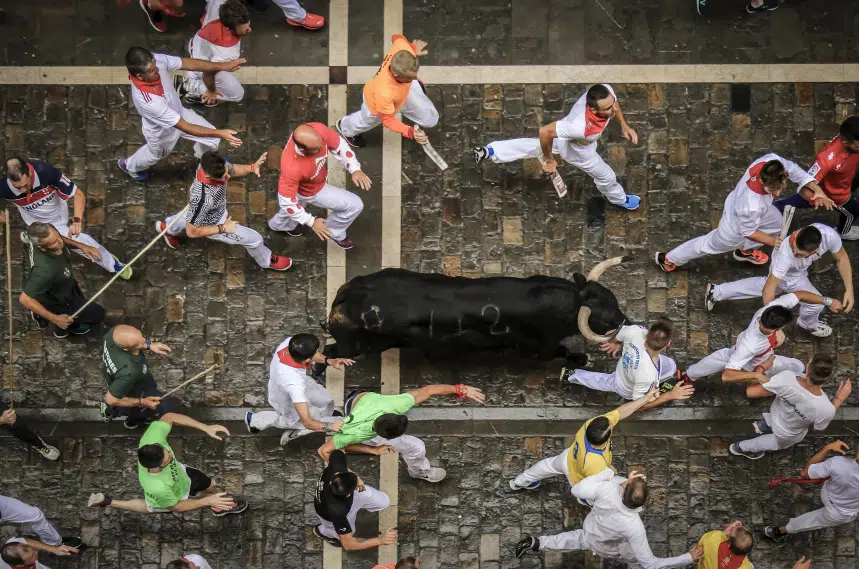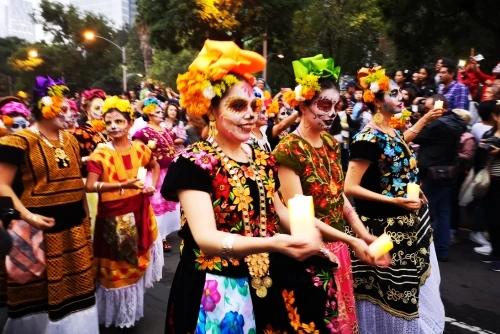The Hispanic and Spanish-speaking population have distinct behaviors that should be recognized by businesses of…
14 of the Most Festive Hispanic Holidays
When it comes to celebrating the richness of culture and traditions, few regions in the world can rival the vibrant and colorful Hispanic heritage. Throughout the year, Hispanic communities across the globe come together to commemorate a wide array of Hispanic holidays that showcase their unique customs, histories, and flavors.
From lively parades and rhythmic dances to mouthwatering cuisine and heartfelt religious observances, these celebrations are a testament to the diverse tapestry of Hispanic culture. Let’s celebrate these festivities as the experts in English to Spanish translation services in Raleigh explore the most festive Hispanic holidays.
Día de los Reyes Magos (Three Kings’ Day)
When It’s Celebrated: January 6th
Día de los Reyes Magos, or Three Kings’ Day, celebrates the biblical story of the Magi’s journey to present gifts to the baby Jesus. Observed in Spain, Mexico, and across Latin America, it is a day filled with joyful traditions that emphasize family, faith, and generosity. This is one of the many Hispanic holidays particularly special for children, who eagerly await gifts from the Three Kings.
Día de los Reyes Traditions
Three Kings’ Day is one of many hispanic celebrations filled with meaningful customs and delicious treats, including:
- Rosca de Reyes: This crown-shaped sweet bread, adorned with dried fruits to represent jewels, contains a hidden figurine of baby Jesus. Whoever finds the figurine hosts a tamale feast on Día de la Candelaria (February 2nd).
- Festive Clothing and Parades: Performers dressed as the Three Kings wear regal robes, while families gather in festive attire to enjoy Cabalgatas de Reyes, parades featuring floats, music, and candy-throwing.
- Preparing for the Kings: On the night of January 5th, children leave their shoes out with hay or grass for the Kings’ camels, receiving small gifts or candies in return. Homes are decorated with figurines of the Magi and nativity scenes.
Traditional Foods: In addition to Rosca de Reyes, celebrations include hot chocolate, churros, and tamales. In Spain, turrón (nougat candy) and cava (sparkling wine) are festive favorites.
Fiesta de la Candelaria
Fiesta de la Candelaria, also known as Candlemas, is one of the significant hispanic holidays celebrated in various Latin American countries, particularly in Mexico and Peru. It commemorates the presentation of Jesus at the Temple and the purification of the Virgin Mary, blending Christian tradition with indigenous cultural elements. The day is marked by vibrant ceremonies, music, and community celebrations, reflecting the fusion of faith and local heritage.

Candlemas Traditions
Fiesta de la Candelaria, much like other holidays in spanish speaking countries, is celebrated with a blend of religious devotion, cultural expression, and communal joy, including:
- Dressing Sacred Figures: Statues of the Virgin Mary and the Child Jesus are dressed in intricate, handcrafted outfits adorned with embroidery, beads, and lace, symbolizing reverence and devotion.
- Processions with Music and Dance: The adorned statues are carried through the streets in vibrant processions accompanied by traditional songs, indigenous dances, and participants carrying candles to symbolize purification and light.
Festive Foods and Gatherings: Families and communities share meals featuring tamales and atole, emphasizing unity, gratitude, and the festive spirit of the occasion.
Carnaval
When It’s Celebrated: Varies by region; typically in the week leading up to Lent (February or March)
Carnaval is one of the globally recognized hispanic holidays and traditions. The festival is filled with vibrant celebrations, music, and creativity. Rooted in the Catholic tradition of indulging before Lent’s austerity, Carnaval takes on unique forms in different Hispanic and international regions. It is a time of community revelry, showcasing local cultures and traditions through music, costumes, and dance.
Carnaval Traditions
When it comes to hispanic holidays celebrated around the world, Carnaval is most well-known as a vibrant celebration of creativity, music, and indulgence. Each region adds its unique cultural flair, with key traditions including:
- Dazzling Costumes: From samba costumes in Brazil adorned with feathers and sequins to ornate Venetian masks and Trinidad’s fusion of African, Indian, and European designs, costumes embody the festive spirit.
- Music and Dance: Samba, calypso, soca, and traditional dances like cumbia and salsa set the rhythm, with live performances energizing parades and gatherings.
- Parades and Performances: Iconic parades like Rio’s Sambadrome competition and folkloric processions in Barranquilla showcase artistry and local traditions.
Festive Foods and Drinks: Revelers enjoy street foods such as empanadas and tamales, sweet treats like churros, and refreshing regional drinks, including chicha and rum-based cocktails.
Semana Santa (Holy Week)
When It’s Celebrated: The week leading up to Easter Sunday (dates vary annually)
Semana Santa, or Holy Week, is one of the most significant and deeply religious Hispanic holidays celebrated in Spanish speaking countries. It commemorates the Passion, Death, and Resurrection of Jesus Christ. Each day of the week features solemn processions, religious ceremonies, and reenactments of key biblical events, such as the Last Supper, the Crucifixion, and the Resurrection. The holiday blends Catholic tradition with local customs, making it a powerful cultural and spiritual event.
Holy Week Traditions
Semana Santa is one of the profound hispanic celebrations that blend faith, art, and community, marked by solemn processions, artistic displays, and traditional meals. Traditions often include:
- Religious Attire and Symbols: Participants wear Nazareno robes, carry candles and crosses, and incorporate indigenous elements in Latin America, reflecting the fusion of cultures.
- Elaborate Processions: Iconic processions in Spain and reenactments of the Passion of Christ in Latin America bring biblical stories to life with statues, music, and reverent gatherings.
- Artistic Displays: Stunning street carpets made of sawdust and flowers, alongside sacred art, enhance the visual splendor of the celebrations.
Traditional Foods: Families share meals featuring torrejas (sweet bread), fish, seafood, and tamales, honoring Lenten customs.
El Día del Niño (Children’s Day)
When It’s Celebrated: April 30th (in Mexico; dates vary by country)
El Día del Niño, or Children’s Day, is a one of the special hispanic holidays to celebrate and honor children. Observed in many Hispanic countries, the day emphasizes the importance of childhood, education, and the well-being of young ones. It’s a joyful occasion filled with fun activities, gifts, and family gatherings. Schools, communities, and organizations often host events to make children feel loved and valued.
El Día del Niño Traditions
El Día del Niño is a joyful celebration dedicated to honoring and cherishing children, filled with vibrant activities, treats, and quality family time, including:
- Festive Attire: Children often wear colorful and playful outfits, with schools hosting themed dress-up days or costume parades showcasing favorite characters or cultural attire.
- Delicious Foods and Treats: Elaborate cakes, piñatas filled with candy, and kid-friendly favorites like hot dogs, tacos, and colorful gelatin desserts are staples of the celebrations.
- Community and School Events: Schools organize games, dances, and performances, while communities hold toy drives, distribute gifts, and host piñata-breaking activities that delight children.
- Family Outings: Families spend quality time together at parks, movies, zoos, or museums, many of which offer special events or discounts to mark the occasion.
Celebration of Childhood: The day highlights the importance of nurturing and protecting children, fostering unity, joy, and appreciation in families and communities alike.
Cinco de Mayo
When It’s Celebrated: May 5th
Cinco de Mayo, often mistaken for Mexican Independence Day, commemorates the Mexican army’s unexpected victory over French forces at the Battle of Puebla on May 5, 1862, during the Franco-Mexican War. This triumph symbolizes Mexican resilience and patriotism. While it’s not a federal holiday in Mexico, Cinco de Mayo is widely celebrated in the United States as a day to honor Mexican culture and heritage, with festivities showcasing traditional music, dance, and cuisine. This makes it one of the most celebrated Hispanic holidays in the U.S.
Cinco de Mayo Traditions
Cinco de Mayo is a festive celebration of Mexican heritage, these Hispanic holidays blend cultural pride, historical remembrance, and joyous gatherings that include:
- Festive Attire: Women wear folklórico dresses with vibrant colors and embroidery, men don ornate charro suits, and sombreros and scarves enhance the lively atmosphere.
- Parades and Reenactments: Public events include parades with floats, mariachi bands, and folkloric dancers, as well as reenactments of the Battle of Puebla that honor Mexican resilience.
- Traditional Foods and Drinks: Iconic dishes like tacos and enchiladas, guacamole with tortilla chips, and beverages such as margaritas and Mexican beer highlight the culinary celebrations.
Music and Dance: Mariachi bands, folklórico dances, and genres like ranchera and norteño energize the festivities, showcasing the rich rhythms of Mexican culture.
Fiesta de San Juan (Feast of Saint John)
When It’s Celebrated: June 23rd and 24th, coinciding with the summer solstice
Fiesta de San Juan, or the Feast of Saint John, is a one of the vibrant Hispanic holidays blending Christian traditions with ancient pagan rituals tied to the summer solstice. Observed in Spain and many Latin American countries, this holiday honors Saint John the Baptist while embracing themes of renewal, purification, and the power of light. The Hispanic celebrations include bonfires, music, dancing, and shared meals, bringing communities together for a magical celebration under the summer sky.
Fiesta de San Juan Traditions
Fiesta de San Juan blends ancient solstice rituals with lively celebrations of community and renewal. Key traditions include:
- Festive Attire: Participants often wear light, summery clothing, with white outfits symbolizing purity and accessories featuring fire or sun motifs to reflect the solstice theme.
- Bonfires and Rituals: Bonfires symbolize the sun’s power and purification, with traditions like leaping over flames for good luck, burning wishes as a symbolic act of renewal, and midnight sea baths for cleansing and fortune.
- Traditional Foods and Drinks: Communal feasts include queso de San Juan, herb-infused drinks with symbolic healing properties, and barbecue-style meals featuring grilled meats and seafood.
Music and Dancing: Folk songs and group dances around bonfires bring life to the celebrations, while beaches and plazas serve as vibrant hubs for communal gatherings late into the night.
San Fermín (Running of the Bulls)
When It’s Celebrated: July 6th to July 14th

San Fermín is a week-long festival held annually in Pamplona, Spain, honoring Saint Fermin, the patron saint of Navarra. Famous worldwide for the Running of the Bulls (Encierro), the event is a thrilling mix of tradition, bravery, and celebration. The festival features religious ceremonies, parades, live music, and nonstop revelry, remaining one of the Hispanic holidays to attract visitors from across the globe to witness and participate in its unique and sometimes dangerous traditions.
San Fermín Traditions
San Fermín, celebrated in Pamplona, Spain, is a vibrant festival blending tradition, community, and high-energy events. Key traditions include:
- Red and White Attire: Participants wear white clothing to symbolize purity, paired with red scarves (pañuelos) and sashes (fajas) to honor Saint Fermin, creating a striking visual contrast.
- The Running of the Bulls (Encierro): The festival’s hallmark event sees runners (mozos) sprinting alongside bulls through Pamplona’s cobblestone streets, covering 875 meters in a thrilling display of courage and agility.
- Traditional Foods and Drinks: Popular treats include churros with chocolate for breakfast, pinchos (tapas-style snacks), and sangria, which flows freely during the festivities.
- Religious and Cultural Ceremonies: The Chupinazo (rocket launch) marks the festival’s start, followed by daily processions where devotees honor Saint Fermin with music, dancing, and a statue parade.
- Music, Dancing, and Nightlife: Marching bands, fireworks, and street parties create a lively atmosphere, with celebrations continuing into the early hours.
- Tradition and Controversy: While iconic for its cultural significance, the bull-related events have drawn criticism from animal rights advocates, yet the festival remains a cornerstone of Spanish heritage.
Guelaguetza Festival
The Guelaguetza Festival, also known as the “Fiesta de la Guelaguetza,” is a renowned cultural celebration in Oaxaca, Mexico. It typically takes place in late July and showcases the rich and diverse indigenous traditions of the region.
The festival features vibrant dance performances, colorful costumes, traditional music, and displays of artisanal crafts and cuisine in celebration of one of the most popular Hispanic holidays around the world.
One of its main purposes is to promote and preserve the unique cultures and traditions of Oaxaca’s various indigenous communities, making it a significant cultural event that attracts visitors from around the world.
Día de la Independencia (Independence Day)
When It’s Celebrated: Dates vary by country, for instance in Mexico it’s celebrated September 16th, and in Colombia it’s celebrated on July 20th.
Día de la Independencia, or Independence Day, is one of the most important national holidays in Hispanic countries, celebrating their liberation from Spanish colonial rule. During these Hispanic holidays, each country commemorates its unique history of independence with patriotic displays, cultural events, and community gatherings. The holiday is a time to honor the struggles and sacrifices of those who fought for freedom while fostering unity and national pride.
Día de la Independencia Traditions
Independence Day celebrations across Hispanic countries blend patriotism, cultural pride, and joyous festivities, including:
- Patriotic Attire: Outfits like Mexico’s charro suits and Adelita dresses or Colombia’s polleras and linen suits reflect national heritage, often paired with flags, pins, or face paint in patriotic colors.
- Parades and Decorations: Military parades and cultural processions showcase national pride, while streets and buildings are adorned with flags, bunting, and other patriotic symbols.
- Historical Reenactments: Mexico’s Grito de Dolores reenacts the 1810 cry for independence, while other countries bring history to life with pageantry and performances.
- Traditional Foods and Drinks: Festive meals include dishes like chiles en nogada in Mexico and arepas in Colombia, alongside aguas frescas, tequila, aguapanela, and coffee. Sweets like flan and buñuelos complete the celebrations.
Music, Dancing, and Fireworks: Mariachi bands, folkloric dances, and vibrant fireworks displays fill the night with excitement and cultural expression.
Día de los Muertos (Day of the Dead)
When It’s Celebrated: November 1st (Día de los Inocentes) and November 2nd (Día de los Difuntos)

Día de los Muertos, or Day of the Dead, is a colorful and deeply meaningful celebration that honors deceased loved ones. Rooted in indigenous Mesoamerican traditions and Catholic influences, it is most prominently observed in Mexico but is one of the Hispanic holidays celebrated across Latin America and Spanish-speaking communities worldwide. The holiday reflects a joyful acceptance of life and death, focusing on the spiritual connection between the living and the departed.
Día de los Muertos Traditions
Día de los Muertos is a vibrant and deeply symbolic celebration that honors loved ones who have passed while embracing the cycle of life and death. Traditions often include:
- Symbolic Attire: Women often wear Catrina-inspired dresses and paint their faces as sugar skulls, while others opt for traditional regional clothing like embroidered blouses or rebozos.
- Ofrendas (Altars): Altars are decorated with marigolds (to guide spirits), photos, personal items, and offerings of favorite foods like tamales and Pan de Muerto, alongside candles and incense to light the way.
- Cemetery Visits: Families clean and decorate graves with flowers and candles, holding vigils where they share stories, play music, and connect with the spirits of their loved ones.
- Festive Foods: Pan de Muerto, sugar skulls, tamales, mole, hot chocolate, and atole are central to the celebrations, blending tradition with communal joy.
Music, Dance, and Art: Mariachi bands, skeleton-themed folk dances, papel picado, and sugar skull art add vibrant, creative elements to the festivities, celebrating life in a colorful, communal way.
American Thanksgiving
When It’s Celebrated: The fourth Thursday of November
Though not what one may traditionally think of when considering Hispanic holidays, Thanksgiving has become an important occasion for many Hispanic families and communities in the United States. Rooted in the history of early European settlers, Thanksgiving is a time to reflect on gratitude and gather with loved ones. For Hispanic families, the holiday often represents a unique blend of cultures, combining traditional American customs with Hispanic flavors, music, and traditions, reflecting the multicultural fabric of the United States.
Thanksgiving Traditions in Hispanic Families
Thanksgiving in Hispanic households blends American customs with vibrant cultural traditions, creating a unique celebration of gratitude and heritage rooted deep in the same values as many other Hispanic holidays, including:
- Fusion Attire: Families embrace festive clothing, such as guayaberas, embroidered blouses, or shawls, reflecting their Hispanic heritage, alongside casual or semi-formal outfits suited for shared meals.
- A Culinary Blend: Thanksgiving tables mix classic dishes like turkey and stuffing with Hispanic staples such as tamales, arroz con gandules, empanadas, and desserts like flan and tres leches cake.
- Family-Centered Celebrations: Multi-generational cooking, prayers of gratitude, and shared reflections foster togetherness, often complemented by lively music and dance.
Cultural Blending and Diversity: Thanksgiving becomes an opportunity to honor Hispanic heritage while embracing American traditions, with shared stories of immigration and multicultural connections enriching the celebration.
Día de la Virgen de Guadalupe
When It’s Celebrated: December 12th
Día de la Virgen de Guadalupe is one of the most important religious celebrations in Mexico, honoring the Virgin of Guadalupe, the patron saint of the country. As one of many religious Hispanic holidays commonly celebrated, this event commemorates the apparition of the Virgin Mary to Juan Diego, an indigenous man, in 1531 on Tepeyac Hill (modern-day Mexico City). This event symbolizes the unification of Spanish Catholicism and indigenous beliefs, and the Virgin of Guadalupe is a powerful cultural and spiritual figure.
Día de la Virgen de Guadalupe Traditions
Día de la Virgen de Guadalupe is a deeply spiritual and cultural celebration that honors the Virgin Mary as a symbol of devotion and identity through the following traditions:
- Pilgrimage Attire: Pilgrims wear traditional clothing such as tilmas, resembling Juan Diego’s cloak, or colorful Mexican outfits like huipiles and festive dresses adorned with images of the Virgin.
- Communal Foods: Offerings and shared meals include tamales, atole, and pozole, emphasizing unity and tradition during gatherings.
- Masses and Serenades: The day begins with Las Mañanitas, a traditional song of praise, followed by special masses featuring floral displays and music dedicated to the Virgin.
- Pilgrimage to the Basilica: Millions travel to the Basilica of Our Lady of Guadalupe in Mexico City, bringing flowers, candles, and prayers to one of the most significant Catholic sites in the world.
Cultural Performances: Indigenous dances and reenactments of the Virgin’s apparition are performed in plazas and courtyards, celebrating the blend of indigenous traditions and Catholic faith.
Las Posadas
When It’s Celebrated: December 16th to December 24th
Las Posadas is a cherished Mexican Christmas tradition that reenacts Mary and Joseph’s journey to find lodging in Bethlehem before the birth of Jesus. This nine-day celebration is both a religious observance and a time for community gatherings, symbolizing the Nativity story while fostering generosity and togetherness. The festivities blend faith, culture, and hospitality, making it a beloved part of the holiday season in Mexico and Hispanic communities worldwide.
Las Posadas Traditions
Las Posadas is one of the vibrant and heartwarming Hispanic holidays honoring the Mexican tradition of reenacting Mary and Joseph’s journey while fostering community, faith, and festive joy. Key traditions include:
- Festive Attire: Participants dress as Nativity figures like Mary, Joseph, angels, and shepherds, while others wear warm, traditional clothing for the outdoor processions.
- Nightly Processions: Groups visit homes singing villancicos, symbolically seeking shelter as Mary and Joseph did. Candles illuminate the journey, and decorated homes welcome participants at the end.
- Festive Foods and Drinks: Celebrations include tamales, ponche navideño (spiced fruit punch), buñuelos (fried pastries), and atole, creating a comforting communal meal.
- Piñatas and Entertainment: Children delight in breaking star-shaped piñatas, symbolizing triumph over sin, which are filled with candy, fruits, and small toys.
Community Spirit and Faith: The event emphasizes unity, generosity, and religious reflection, with prayers and readings underscoring the spiritual meaning of the season.
Tus Servicios de Traducción en Raleigh
Tus Servicios de Traducción en Raleigh
Celebrate the rich traditions, vibrant culture, and deep sense of community that make Hispanic holidays such a cherished and meaningful part of our lives. Join us as we bridge the gap between cultures and communities in Raleigh and the surrounding areas. Our translation services from English to Spanish Raleigh are here to assist you in conveying messages accurately and with cultural sensitivity.
Our translation services are for locals to the Triangle as well as available virtually nationwide Whether you need to translate business documents or legal contracts, would like your website proofread, or any other translation services, we are ready to work with you.
Contact us today to start building stronger and more effective connections by calling 919-629-0020 or filling out the form below.
Contact a Translator
Talk with a native Spanish-speaking translator about your next translation project.
Related Posts
- Spanish AdWords Use in Hispanic Marketing
- Top Hispanic Holiday Traditions
Just like the United States, Christmas time is a favorite times of the year amongst…
- Interesting Facts about the Hispanic Population
Read these interesting facts about the Hispanic population in Raleigh, North Carolina.
